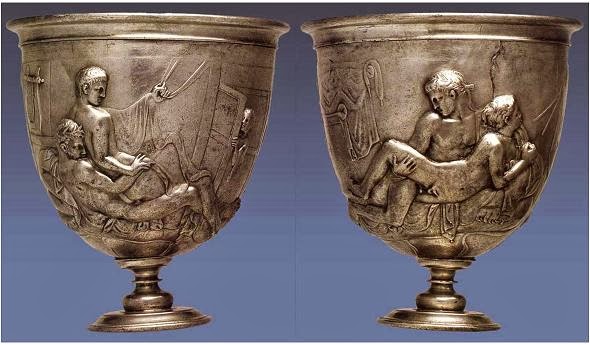Warren Cup
Dec. 7th, 2020 02:10 pmOne of my favourite items in the British Museum is the famous Greek Warren Cup.

A classic piece of homoerotic images adorn the Warren Cup which is an ancient Greco-Roman silver drinking cup decorated in relief with two images of male same-sex acts. It was purchased by the British Museum for £1.8 million in 1999, the most expensive single purchase by the museum at that time. It is usually dated to the time of the Julio-Claudian dynasty (1st century AD).
The cup is named after its first modern owner, Edward Perry Warren, notable for his art collection, which also included Rodin's The Kiss statue and Cranach's Adam and Eve painting.
Representations of sexual acts are widely found in Roman art, although surviving male-female scenes greatly outnumber same-sex couples. It cannot be assumed that homoerotic art was uncommon as the modern record may be biased due to selective destruction or non-publication of pederastic works in later times.
Both scenes show draped textiles in the background, as well as a cithara (appearing as an eleven-stringed lyre, often symbolic of pleasure and drinking parties) in the former scene and tibiae (reeded pipes) with finger holes being depicted in the latter. These, along with the careful delineation of ages and status and the wreaths worn by the youths, all suggest a cultured, elite, Hellenized setting with music and entertainment.
Exquisite in my opinion.

A classic piece of homoerotic images adorn the Warren Cup which is an ancient Greco-Roman silver drinking cup decorated in relief with two images of male same-sex acts. It was purchased by the British Museum for £1.8 million in 1999, the most expensive single purchase by the museum at that time. It is usually dated to the time of the Julio-Claudian dynasty (1st century AD).
The cup is named after its first modern owner, Edward Perry Warren, notable for his art collection, which also included Rodin's The Kiss statue and Cranach's Adam and Eve painting.
Representations of sexual acts are widely found in Roman art, although surviving male-female scenes greatly outnumber same-sex couples. It cannot be assumed that homoerotic art was uncommon as the modern record may be biased due to selective destruction or non-publication of pederastic works in later times.
Both scenes show draped textiles in the background, as well as a cithara (appearing as an eleven-stringed lyre, often symbolic of pleasure and drinking parties) in the former scene and tibiae (reeded pipes) with finger holes being depicted in the latter. These, along with the careful delineation of ages and status and the wreaths worn by the youths, all suggest a cultured, elite, Hellenized setting with music and entertainment.
Exquisite in my opinion.